Emergency Management: Principles, Recovery, and UK Incident Examples
VerifiedAdded on 2020/12/09
|14
|3603
|128
Report
AI Summary
This report delves into the principles of integrated emergency management, emphasizing effective incident response and the critical recovery stage. It outlines the multi-agency framework and the importance of debriefing and review for future planning. The report provides examples of emergency incidents in the UK, such as the Parsons Green terrorist attack, and discusses incidents at the international level. It also examines the role of public services, particularly the National Health Service (NHS), in managing these incidents and the various stages of recovery, including humanitarian, economic, infrastructure, and environmental aspects. The report highlights opportunities for regeneration and the need for continuous evaluation of plans and policies to mitigate risks and improve future responses. The report also discusses the importance of media management during emergency situations, highlighting the role of the Science and Technical Advice Cell (STAC) in providing analysis and recommendations.
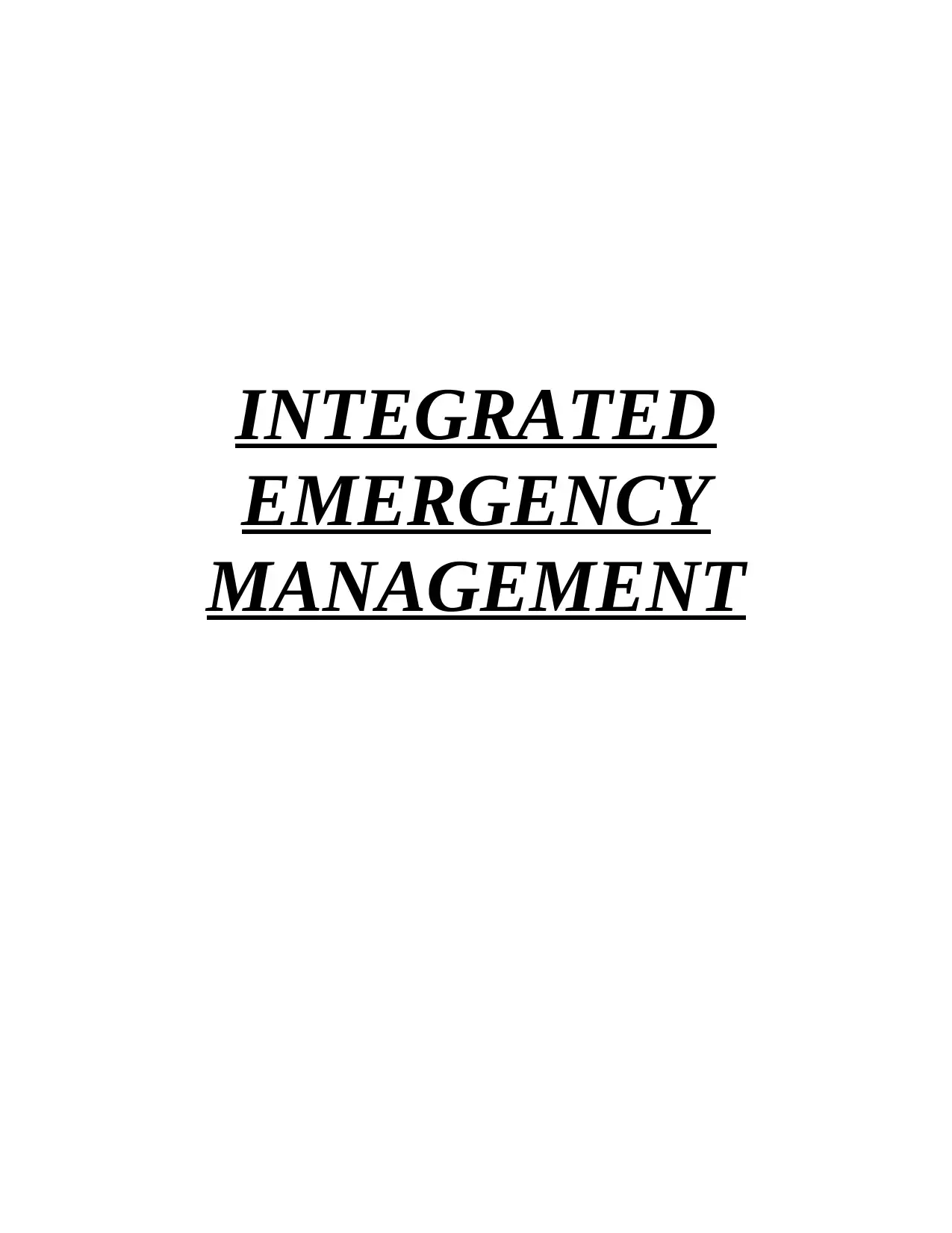
INTEGRATED
EMERGENCY
MANAGEMENT
EMERGENCY
MANAGEMENT
Paraphrase This Document
Need a fresh take? Get an instant paraphrase of this document with our AI Paraphraser
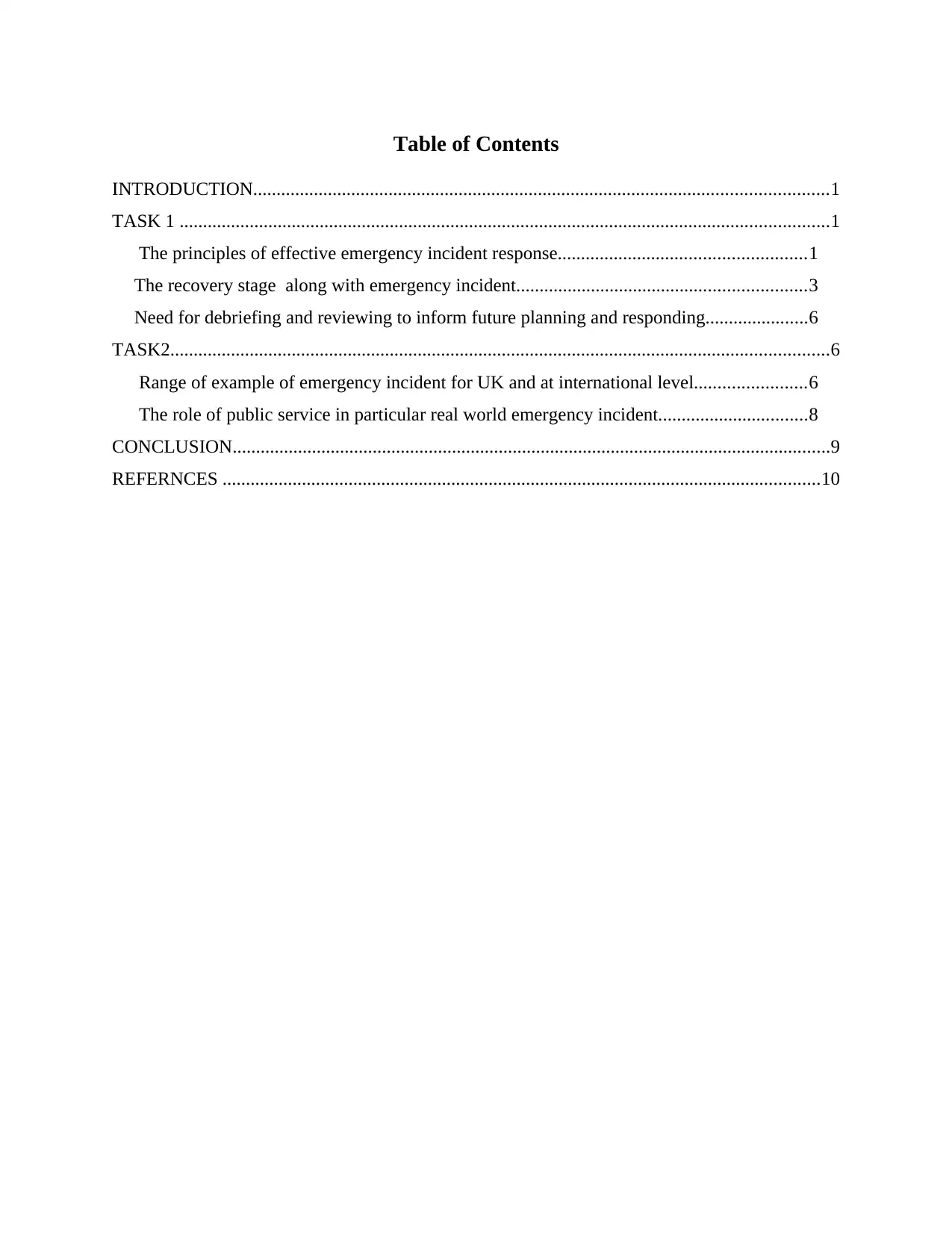
Table of Contents
INTRODUCTION...........................................................................................................................1
TASK 1 ...........................................................................................................................................1
The principles of effective emergency incident response.....................................................1
The recovery stage along with emergency incident..............................................................3
Need for debriefing and reviewing to inform future planning and responding......................6
TASK2.............................................................................................................................................6
Range of example of emergency incident for UK and at international level........................6
The role of public service in particular real world emergency incident................................8
CONCLUSION................................................................................................................................9
REFERNCES ................................................................................................................................10
INTRODUCTION...........................................................................................................................1
TASK 1 ...........................................................................................................................................1
The principles of effective emergency incident response.....................................................1
The recovery stage along with emergency incident..............................................................3
Need for debriefing and reviewing to inform future planning and responding......................6
TASK2.............................................................................................................................................6
Range of example of emergency incident for UK and at international level........................6
The role of public service in particular real world emergency incident................................8
CONCLUSION................................................................................................................................9
REFERNCES ................................................................................................................................10

⊘ This is a preview!⊘
Do you want full access?
Subscribe today to unlock all pages.

Trusted by 1+ million students worldwide
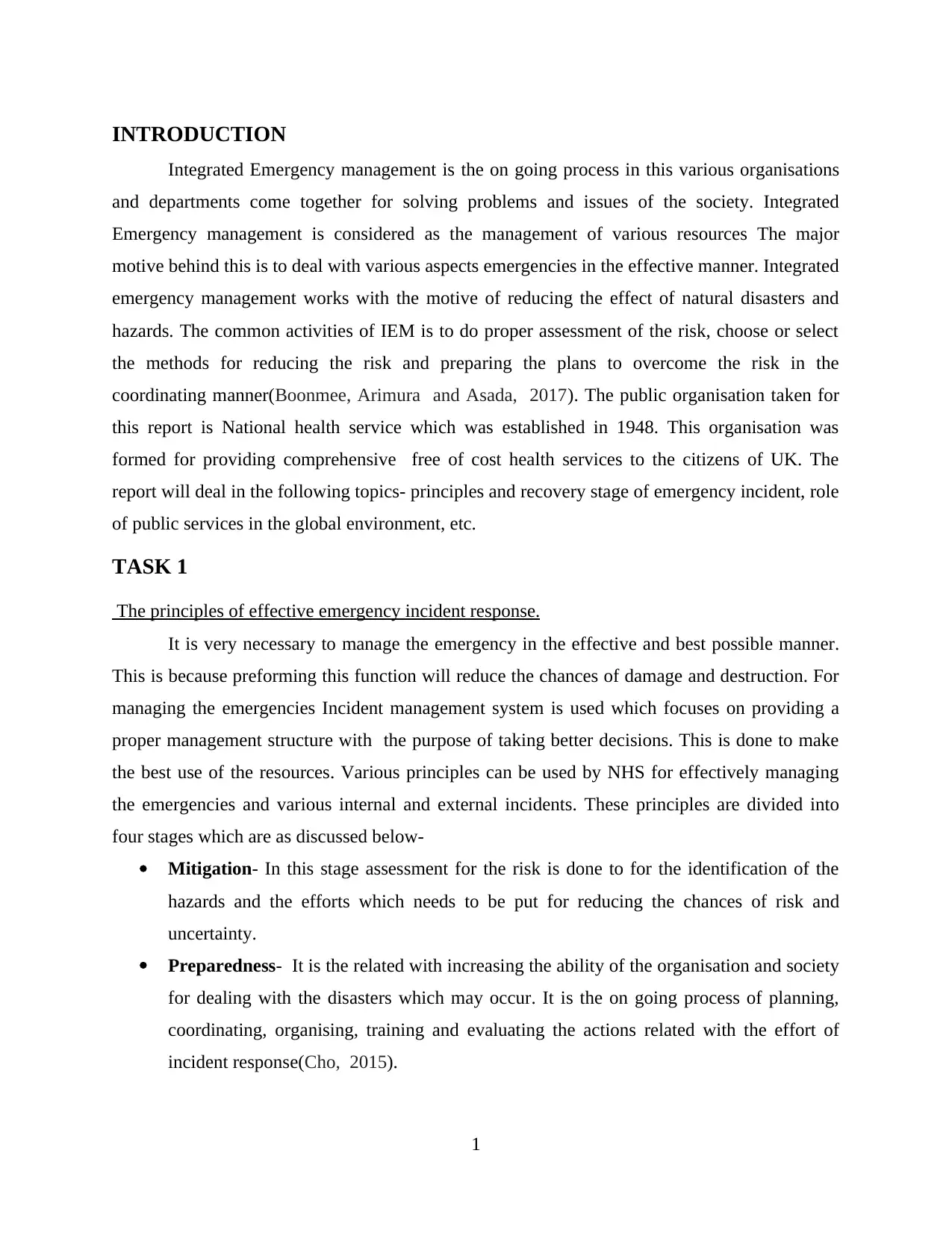
INTRODUCTION
Integrated Emergency management is the on going process in this various organisations
and departments come together for solving problems and issues of the society. Integrated
Emergency management is considered as the management of various resources The major
motive behind this is to deal with various aspects emergencies in the effective manner. Integrated
emergency management works with the motive of reducing the effect of natural disasters and
hazards. The common activities of IEM is to do proper assessment of the risk, choose or select
the methods for reducing the risk and preparing the plans to overcome the risk in the
coordinating manner(Boonmee, Arimura and Asada, 2017). The public organisation taken for
this report is National health service which was established in 1948. This organisation was
formed for providing comprehensive free of cost health services to the citizens of UK. The
report will deal in the following topics- principles and recovery stage of emergency incident, role
of public services in the global environment, etc.
TASK 1
The principles of effective emergency incident response.
It is very necessary to manage the emergency in the effective and best possible manner.
This is because preforming this function will reduce the chances of damage and destruction. For
managing the emergencies Incident management system is used which focuses on providing a
proper management structure with the purpose of taking better decisions. This is done to make
the best use of the resources. Various principles can be used by NHS for effectively managing
the emergencies and various internal and external incidents. These principles are divided into
four stages which are as discussed below-
Mitigation- In this stage assessment for the risk is done to for the identification of the
hazards and the efforts which needs to be put for reducing the chances of risk and
uncertainty.
Preparedness- It is the related with increasing the ability of the organisation and society
for dealing with the disasters which may occur. It is the on going process of planning,
coordinating, organising, training and evaluating the actions related with the effort of
incident response(Cho, 2015).
1
Integrated Emergency management is the on going process in this various organisations
and departments come together for solving problems and issues of the society. Integrated
Emergency management is considered as the management of various resources The major
motive behind this is to deal with various aspects emergencies in the effective manner. Integrated
emergency management works with the motive of reducing the effect of natural disasters and
hazards. The common activities of IEM is to do proper assessment of the risk, choose or select
the methods for reducing the risk and preparing the plans to overcome the risk in the
coordinating manner(Boonmee, Arimura and Asada, 2017). The public organisation taken for
this report is National health service which was established in 1948. This organisation was
formed for providing comprehensive free of cost health services to the citizens of UK. The
report will deal in the following topics- principles and recovery stage of emergency incident, role
of public services in the global environment, etc.
TASK 1
The principles of effective emergency incident response.
It is very necessary to manage the emergency in the effective and best possible manner.
This is because preforming this function will reduce the chances of damage and destruction. For
managing the emergencies Incident management system is used which focuses on providing a
proper management structure with the purpose of taking better decisions. This is done to make
the best use of the resources. Various principles can be used by NHS for effectively managing
the emergencies and various internal and external incidents. These principles are divided into
four stages which are as discussed below-
Mitigation- In this stage assessment for the risk is done to for the identification of the
hazards and the efforts which needs to be put for reducing the chances of risk and
uncertainty.
Preparedness- It is the related with increasing the ability of the organisation and society
for dealing with the disasters which may occur. It is the on going process of planning,
coordinating, organising, training and evaluating the actions related with the effort of
incident response(Cho, 2015).
1
Paraphrase This Document
Need a fresh take? Get an instant paraphrase of this document with our AI Paraphraser
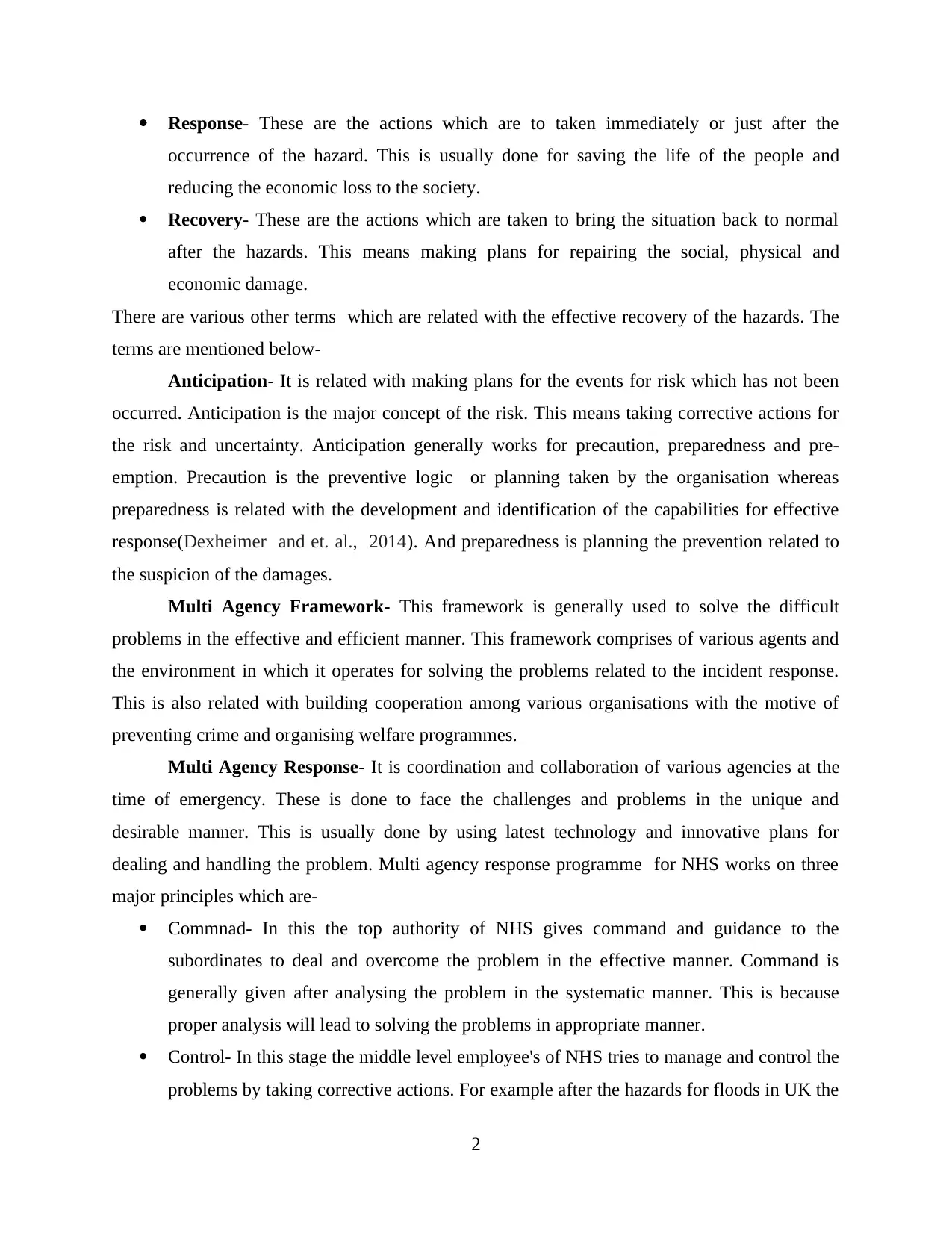
Response- These are the actions which are to taken immediately or just after the
occurrence of the hazard. This is usually done for saving the life of the people and
reducing the economic loss to the society.
Recovery- These are the actions which are taken to bring the situation back to normal
after the hazards. This means making plans for repairing the social, physical and
economic damage.
There are various other terms which are related with the effective recovery of the hazards. The
terms are mentioned below-
Anticipation- It is related with making plans for the events for risk which has not been
occurred. Anticipation is the major concept of the risk. This means taking corrective actions for
the risk and uncertainty. Anticipation generally works for precaution, preparedness and pre-
emption. Precaution is the preventive logic or planning taken by the organisation whereas
preparedness is related with the development and identification of the capabilities for effective
response(Dexheimer and et. al., 2014). And preparedness is planning the prevention related to
the suspicion of the damages.
Multi Agency Framework- This framework is generally used to solve the difficult
problems in the effective and efficient manner. This framework comprises of various agents and
the environment in which it operates for solving the problems related to the incident response.
This is also related with building cooperation among various organisations with the motive of
preventing crime and organising welfare programmes.
Multi Agency Response- It is coordination and collaboration of various agencies at the
time of emergency. These is done to face the challenges and problems in the unique and
desirable manner. This is usually done by using latest technology and innovative plans for
dealing and handling the problem. Multi agency response programme for NHS works on three
major principles which are-
Commnad- In this the top authority of NHS gives command and guidance to the
subordinates to deal and overcome the problem in the effective manner. Command is
generally given after analysing the problem in the systematic manner. This is because
proper analysis will lead to solving the problems in appropriate manner.
Control- In this stage the middle level employee's of NHS tries to manage and control the
problems by taking corrective actions. For example after the hazards for floods in UK the
2
occurrence of the hazard. This is usually done for saving the life of the people and
reducing the economic loss to the society.
Recovery- These are the actions which are taken to bring the situation back to normal
after the hazards. This means making plans for repairing the social, physical and
economic damage.
There are various other terms which are related with the effective recovery of the hazards. The
terms are mentioned below-
Anticipation- It is related with making plans for the events for risk which has not been
occurred. Anticipation is the major concept of the risk. This means taking corrective actions for
the risk and uncertainty. Anticipation generally works for precaution, preparedness and pre-
emption. Precaution is the preventive logic or planning taken by the organisation whereas
preparedness is related with the development and identification of the capabilities for effective
response(Dexheimer and et. al., 2014). And preparedness is planning the prevention related to
the suspicion of the damages.
Multi Agency Framework- This framework is generally used to solve the difficult
problems in the effective and efficient manner. This framework comprises of various agents and
the environment in which it operates for solving the problems related to the incident response.
This is also related with building cooperation among various organisations with the motive of
preventing crime and organising welfare programmes.
Multi Agency Response- It is coordination and collaboration of various agencies at the
time of emergency. These is done to face the challenges and problems in the unique and
desirable manner. This is usually done by using latest technology and innovative plans for
dealing and handling the problem. Multi agency response programme for NHS works on three
major principles which are-
Commnad- In this the top authority of NHS gives command and guidance to the
subordinates to deal and overcome the problem in the effective manner. Command is
generally given after analysing the problem in the systematic manner. This is because
proper analysis will lead to solving the problems in appropriate manner.
Control- In this stage the middle level employee's of NHS tries to manage and control the
problems by taking corrective actions. For example after the hazards for floods in UK the
2
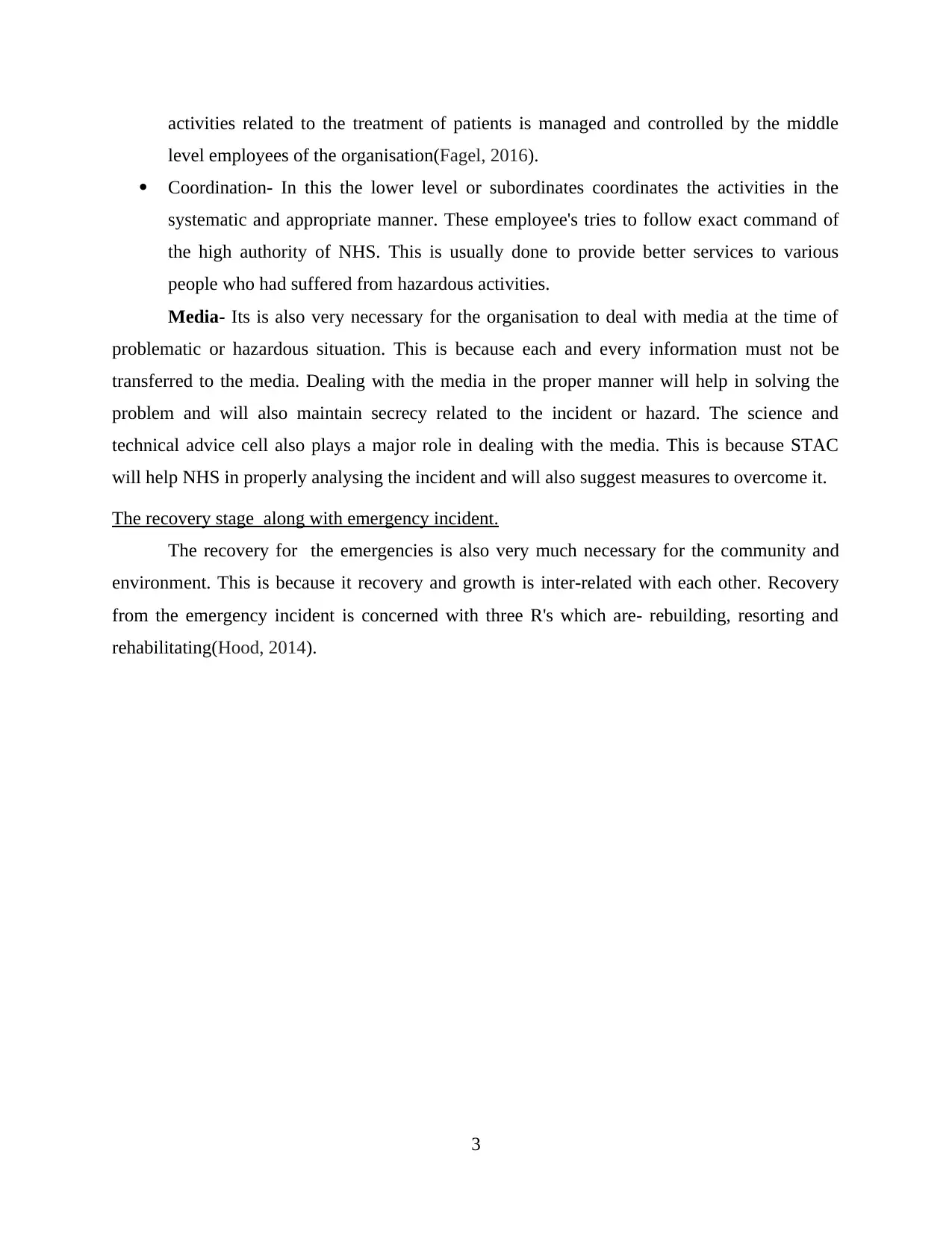
activities related to the treatment of patients is managed and controlled by the middle
level employees of the organisation(Fagel, 2016).
Coordination- In this the lower level or subordinates coordinates the activities in the
systematic and appropriate manner. These employee's tries to follow exact command of
the high authority of NHS. This is usually done to provide better services to various
people who had suffered from hazardous activities.
Media- Its is also very necessary for the organisation to deal with media at the time of
problematic or hazardous situation. This is because each and every information must not be
transferred to the media. Dealing with the media in the proper manner will help in solving the
problem and will also maintain secrecy related to the incident or hazard. The science and
technical advice cell also plays a major role in dealing with the media. This is because STAC
will help NHS in properly analysing the incident and will also suggest measures to overcome it.
The recovery stage along with emergency incident.
The recovery for the emergencies is also very much necessary for the community and
environment. This is because it recovery and growth is inter-related with each other. Recovery
from the emergency incident is concerned with three R's which are- rebuilding, resorting and
rehabilitating(Hood, 2014).
3
level employees of the organisation(Fagel, 2016).
Coordination- In this the lower level or subordinates coordinates the activities in the
systematic and appropriate manner. These employee's tries to follow exact command of
the high authority of NHS. This is usually done to provide better services to various
people who had suffered from hazardous activities.
Media- Its is also very necessary for the organisation to deal with media at the time of
problematic or hazardous situation. This is because each and every information must not be
transferred to the media. Dealing with the media in the proper manner will help in solving the
problem and will also maintain secrecy related to the incident or hazard. The science and
technical advice cell also plays a major role in dealing with the media. This is because STAC
will help NHS in properly analysing the incident and will also suggest measures to overcome it.
The recovery stage along with emergency incident.
The recovery for the emergencies is also very much necessary for the community and
environment. This is because it recovery and growth is inter-related with each other. Recovery
from the emergency incident is concerned with three R's which are- rebuilding, resorting and
rehabilitating(Hood, 2014).
3
⊘ This is a preview!⊘
Do you want full access?
Subscribe today to unlock all pages.

Trusted by 1+ million students worldwide
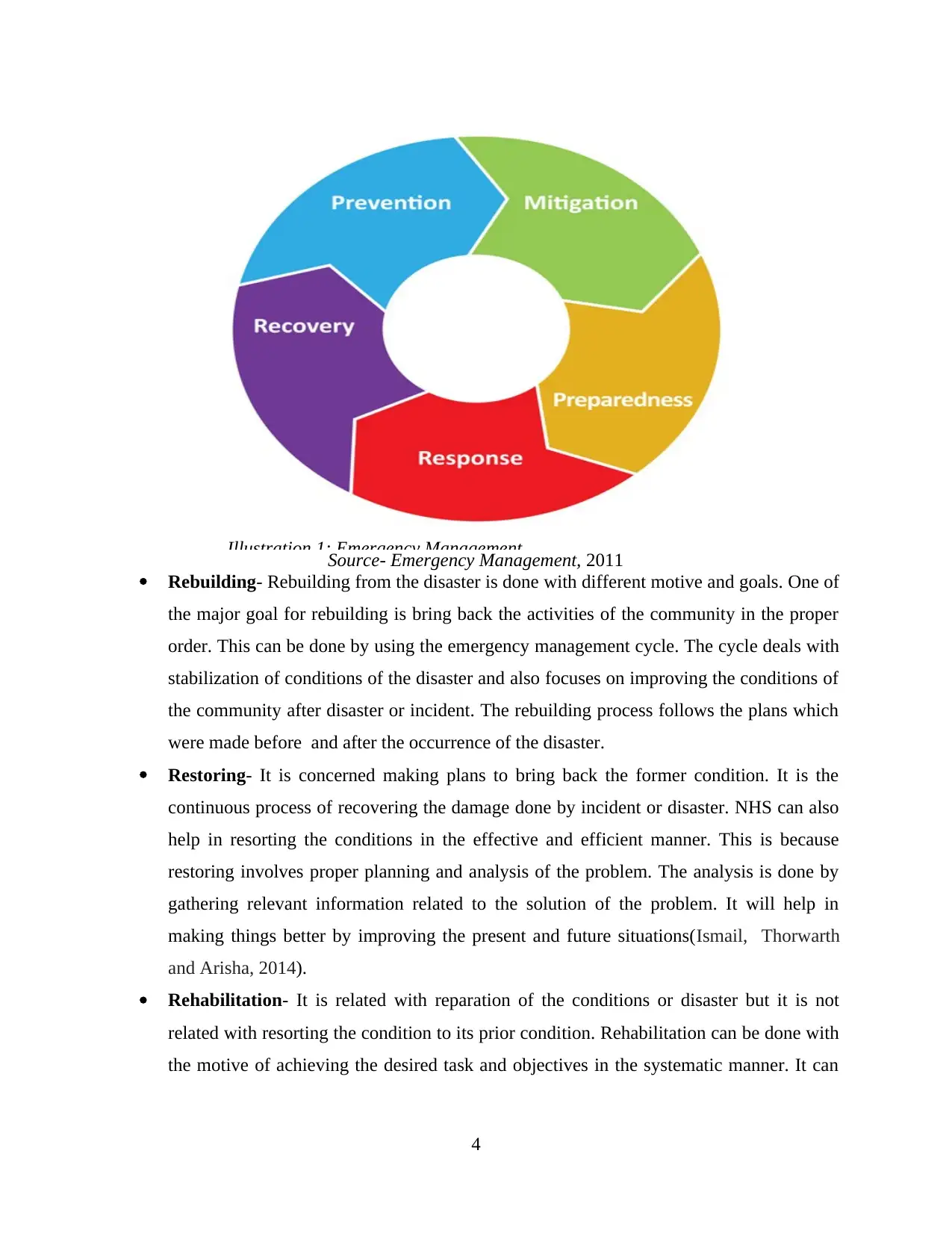
Source- Emergency Management, 2011
Rebuilding- Rebuilding from the disaster is done with different motive and goals. One of
the major goal for rebuilding is bring back the activities of the community in the proper
order. This can be done by using the emergency management cycle. The cycle deals with
stabilization of conditions of the disaster and also focuses on improving the conditions of
the community after disaster or incident. The rebuilding process follows the plans which
were made before and after the occurrence of the disaster.
Restoring- It is concerned making plans to bring back the former condition. It is the
continuous process of recovering the damage done by incident or disaster. NHS can also
help in resorting the conditions in the effective and efficient manner. This is because
restoring involves proper planning and analysis of the problem. The analysis is done by
gathering relevant information related to the solution of the problem. It will help in
making things better by improving the present and future situations(Ismail, Thorwarth
and Arisha, 2014).
Rehabilitation- It is related with reparation of the conditions or disaster but it is not
related with resorting the condition to its prior condition. Rehabilitation can be done with
the motive of achieving the desired task and objectives in the systematic manner. It can
4
Illustration 1: Emergency Management
Rebuilding- Rebuilding from the disaster is done with different motive and goals. One of
the major goal for rebuilding is bring back the activities of the community in the proper
order. This can be done by using the emergency management cycle. The cycle deals with
stabilization of conditions of the disaster and also focuses on improving the conditions of
the community after disaster or incident. The rebuilding process follows the plans which
were made before and after the occurrence of the disaster.
Restoring- It is concerned making plans to bring back the former condition. It is the
continuous process of recovering the damage done by incident or disaster. NHS can also
help in resorting the conditions in the effective and efficient manner. This is because
restoring involves proper planning and analysis of the problem. The analysis is done by
gathering relevant information related to the solution of the problem. It will help in
making things better by improving the present and future situations(Ismail, Thorwarth
and Arisha, 2014).
Rehabilitation- It is related with reparation of the conditions or disaster but it is not
related with resorting the condition to its prior condition. Rehabilitation can be done with
the motive of achieving the desired task and objectives in the systematic manner. It can
4
Illustration 1: Emergency Management
Paraphrase This Document
Need a fresh take? Get an instant paraphrase of this document with our AI Paraphraser
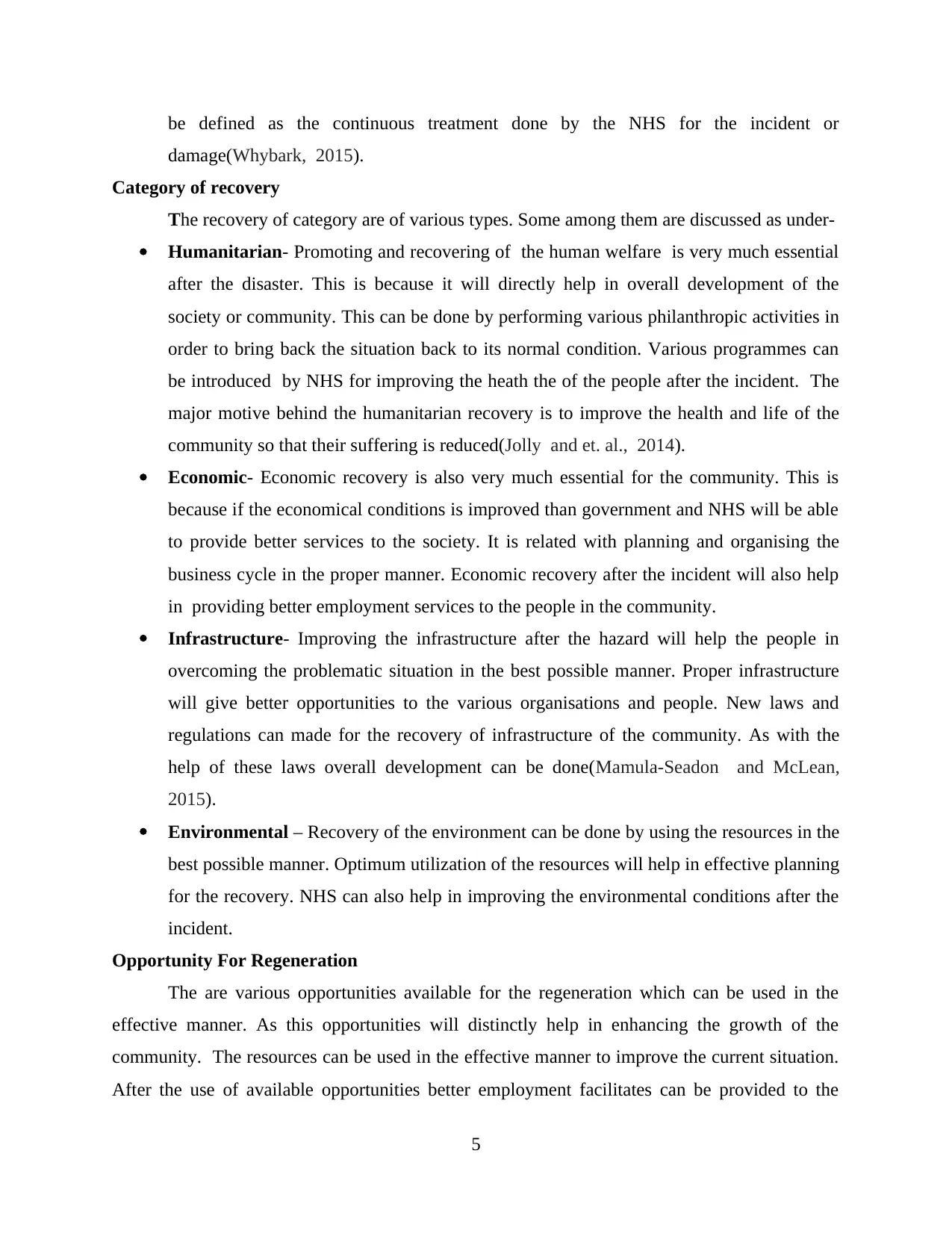
be defined as the continuous treatment done by the NHS for the incident or
damage(Whybark, 2015).
Category of recovery
The recovery of category are of various types. Some among them are discussed as under-
Humanitarian- Promoting and recovering of the human welfare is very much essential
after the disaster. This is because it will directly help in overall development of the
society or community. This can be done by performing various philanthropic activities in
order to bring back the situation back to its normal condition. Various programmes can
be introduced by NHS for improving the heath the of the people after the incident. The
major motive behind the humanitarian recovery is to improve the health and life of the
community so that their suffering is reduced(Jolly and et. al., 2014).
Economic- Economic recovery is also very much essential for the community. This is
because if the economical conditions is improved than government and NHS will be able
to provide better services to the society. It is related with planning and organising the
business cycle in the proper manner. Economic recovery after the incident will also help
in providing better employment services to the people in the community.
Infrastructure- Improving the infrastructure after the hazard will help the people in
overcoming the problematic situation in the best possible manner. Proper infrastructure
will give better opportunities to the various organisations and people. New laws and
regulations can made for the recovery of infrastructure of the community. As with the
help of these laws overall development can be done(Mamula-Seadon and McLean,
2015).
Environmental – Recovery of the environment can be done by using the resources in the
best possible manner. Optimum utilization of the resources will help in effective planning
for the recovery. NHS can also help in improving the environmental conditions after the
incident.
Opportunity For Regeneration
The are various opportunities available for the regeneration which can be used in the
effective manner. As this opportunities will distinctly help in enhancing the growth of the
community. The resources can be used in the effective manner to improve the current situation.
After the use of available opportunities better employment facilitates can be provided to the
5
damage(Whybark, 2015).
Category of recovery
The recovery of category are of various types. Some among them are discussed as under-
Humanitarian- Promoting and recovering of the human welfare is very much essential
after the disaster. This is because it will directly help in overall development of the
society or community. This can be done by performing various philanthropic activities in
order to bring back the situation back to its normal condition. Various programmes can
be introduced by NHS for improving the heath the of the people after the incident. The
major motive behind the humanitarian recovery is to improve the health and life of the
community so that their suffering is reduced(Jolly and et. al., 2014).
Economic- Economic recovery is also very much essential for the community. This is
because if the economical conditions is improved than government and NHS will be able
to provide better services to the society. It is related with planning and organising the
business cycle in the proper manner. Economic recovery after the incident will also help
in providing better employment services to the people in the community.
Infrastructure- Improving the infrastructure after the hazard will help the people in
overcoming the problematic situation in the best possible manner. Proper infrastructure
will give better opportunities to the various organisations and people. New laws and
regulations can made for the recovery of infrastructure of the community. As with the
help of these laws overall development can be done(Mamula-Seadon and McLean,
2015).
Environmental – Recovery of the environment can be done by using the resources in the
best possible manner. Optimum utilization of the resources will help in effective planning
for the recovery. NHS can also help in improving the environmental conditions after the
incident.
Opportunity For Regeneration
The are various opportunities available for the regeneration which can be used in the
effective manner. As this opportunities will distinctly help in enhancing the growth of the
community. The resources can be used in the effective manner to improve the current situation.
After the use of available opportunities better employment facilitates can be provided to the
5
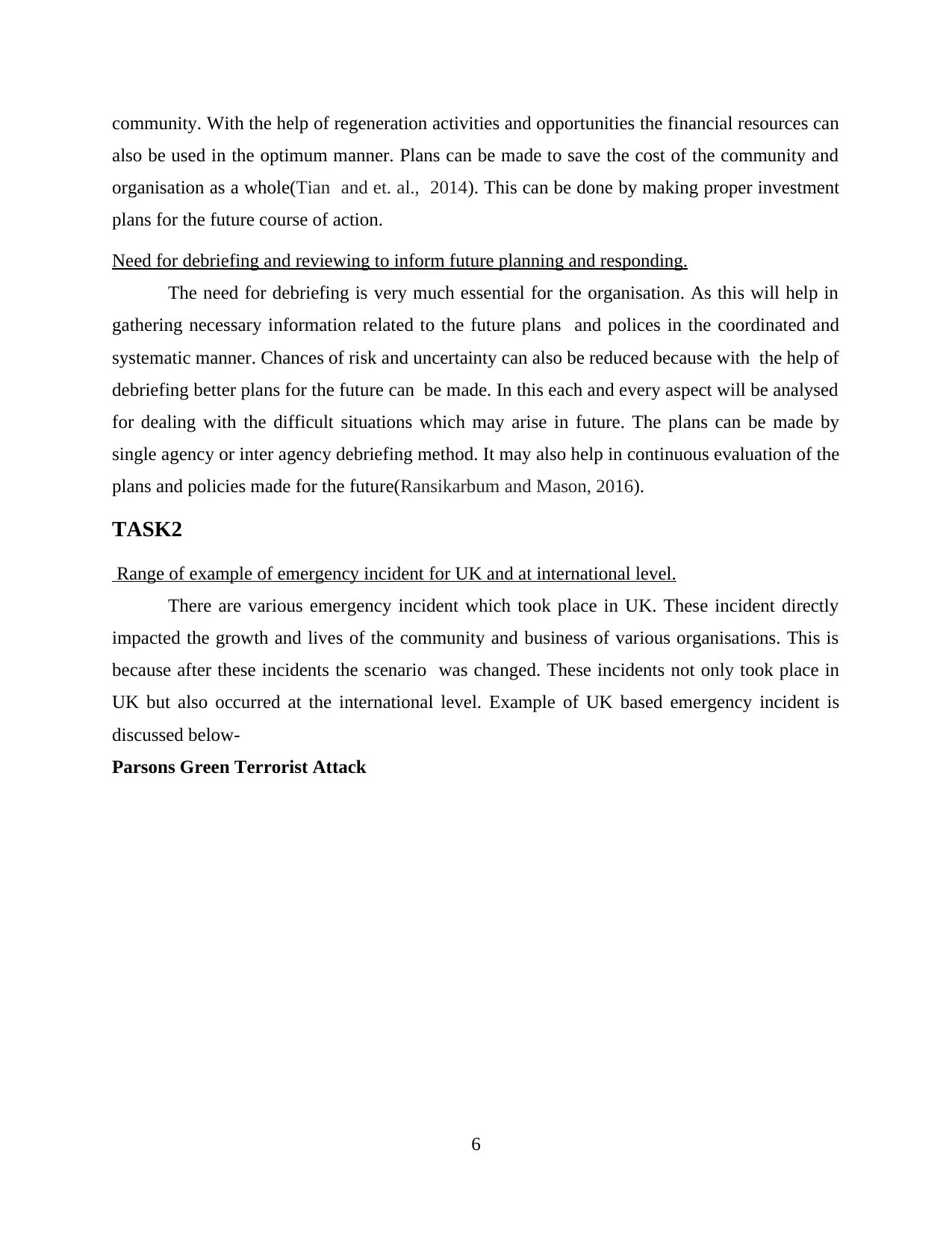
community. With the help of regeneration activities and opportunities the financial resources can
also be used in the optimum manner. Plans can be made to save the cost of the community and
organisation as a whole(Tian and et. al., 2014). This can be done by making proper investment
plans for the future course of action.
Need for debriefing and reviewing to inform future planning and responding.
The need for debriefing is very much essential for the organisation. As this will help in
gathering necessary information related to the future plans and polices in the coordinated and
systematic manner. Chances of risk and uncertainty can also be reduced because with the help of
debriefing better plans for the future can be made. In this each and every aspect will be analysed
for dealing with the difficult situations which may arise in future. The plans can be made by
single agency or inter agency debriefing method. It may also help in continuous evaluation of the
plans and policies made for the future(Ransikarbum and Mason, 2016).
TASK2
Range of example of emergency incident for UK and at international level.
There are various emergency incident which took place in UK. These incident directly
impacted the growth and lives of the community and business of various organisations. This is
because after these incidents the scenario was changed. These incidents not only took place in
UK but also occurred at the international level. Example of UK based emergency incident is
discussed below-
Parsons Green Terrorist Attack
6
also be used in the optimum manner. Plans can be made to save the cost of the community and
organisation as a whole(Tian and et. al., 2014). This can be done by making proper investment
plans for the future course of action.
Need for debriefing and reviewing to inform future planning and responding.
The need for debriefing is very much essential for the organisation. As this will help in
gathering necessary information related to the future plans and polices in the coordinated and
systematic manner. Chances of risk and uncertainty can also be reduced because with the help of
debriefing better plans for the future can be made. In this each and every aspect will be analysed
for dealing with the difficult situations which may arise in future. The plans can be made by
single agency or inter agency debriefing method. It may also help in continuous evaluation of the
plans and policies made for the future(Ransikarbum and Mason, 2016).
TASK2
Range of example of emergency incident for UK and at international level.
There are various emergency incident which took place in UK. These incident directly
impacted the growth and lives of the community and business of various organisations. This is
because after these incidents the scenario was changed. These incidents not only took place in
UK but also occurred at the international level. Example of UK based emergency incident is
discussed below-
Parsons Green Terrorist Attack
6
⊘ This is a preview!⊘
Do you want full access?
Subscribe today to unlock all pages.

Trusted by 1+ million students worldwide
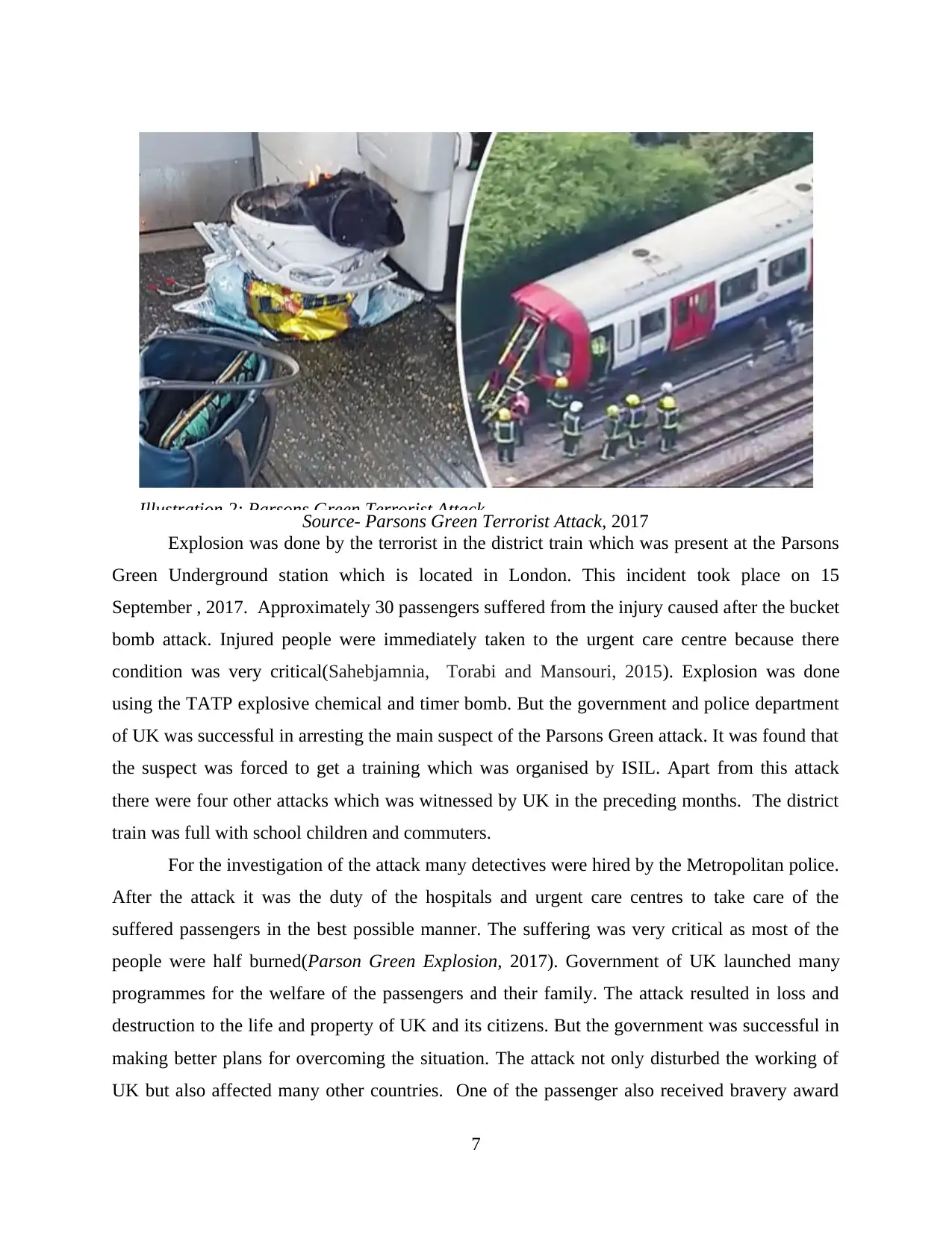
Source- Parsons Green Terrorist Attack, 2017
Explosion was done by the terrorist in the district train which was present at the Parsons
Green Underground station which is located in London. This incident took place on 15
September , 2017. Approximately 30 passengers suffered from the injury caused after the bucket
bomb attack. Injured people were immediately taken to the urgent care centre because there
condition was very critical(Sahebjamnia, Torabi and Mansouri, 2015). Explosion was done
using the TATP explosive chemical and timer bomb. But the government and police department
of UK was successful in arresting the main suspect of the Parsons Green attack. It was found that
the suspect was forced to get a training which was organised by ISIL. Apart from this attack
there were four other attacks which was witnessed by UK in the preceding months. The district
train was full with school children and commuters.
For the investigation of the attack many detectives were hired by the Metropolitan police.
After the attack it was the duty of the hospitals and urgent care centres to take care of the
suffered passengers in the best possible manner. The suffering was very critical as most of the
people were half burned(Parson Green Explosion, 2017). Government of UK launched many
programmes for the welfare of the passengers and their family. The attack resulted in loss and
destruction to the life and property of UK and its citizens. But the government was successful in
making better plans for overcoming the situation. The attack not only disturbed the working of
UK but also affected many other countries. One of the passenger also received bravery award
7
Illustration 2: Parsons Green Terrorist Attack
Explosion was done by the terrorist in the district train which was present at the Parsons
Green Underground station which is located in London. This incident took place on 15
September , 2017. Approximately 30 passengers suffered from the injury caused after the bucket
bomb attack. Injured people were immediately taken to the urgent care centre because there
condition was very critical(Sahebjamnia, Torabi and Mansouri, 2015). Explosion was done
using the TATP explosive chemical and timer bomb. But the government and police department
of UK was successful in arresting the main suspect of the Parsons Green attack. It was found that
the suspect was forced to get a training which was organised by ISIL. Apart from this attack
there were four other attacks which was witnessed by UK in the preceding months. The district
train was full with school children and commuters.
For the investigation of the attack many detectives were hired by the Metropolitan police.
After the attack it was the duty of the hospitals and urgent care centres to take care of the
suffered passengers in the best possible manner. The suffering was very critical as most of the
people were half burned(Parson Green Explosion, 2017). Government of UK launched many
programmes for the welfare of the passengers and their family. The attack resulted in loss and
destruction to the life and property of UK and its citizens. But the government was successful in
making better plans for overcoming the situation. The attack not only disturbed the working of
UK but also affected many other countries. One of the passenger also received bravery award
7
Illustration 2: Parsons Green Terrorist Attack
Paraphrase This Document
Need a fresh take? Get an instant paraphrase of this document with our AI Paraphraser
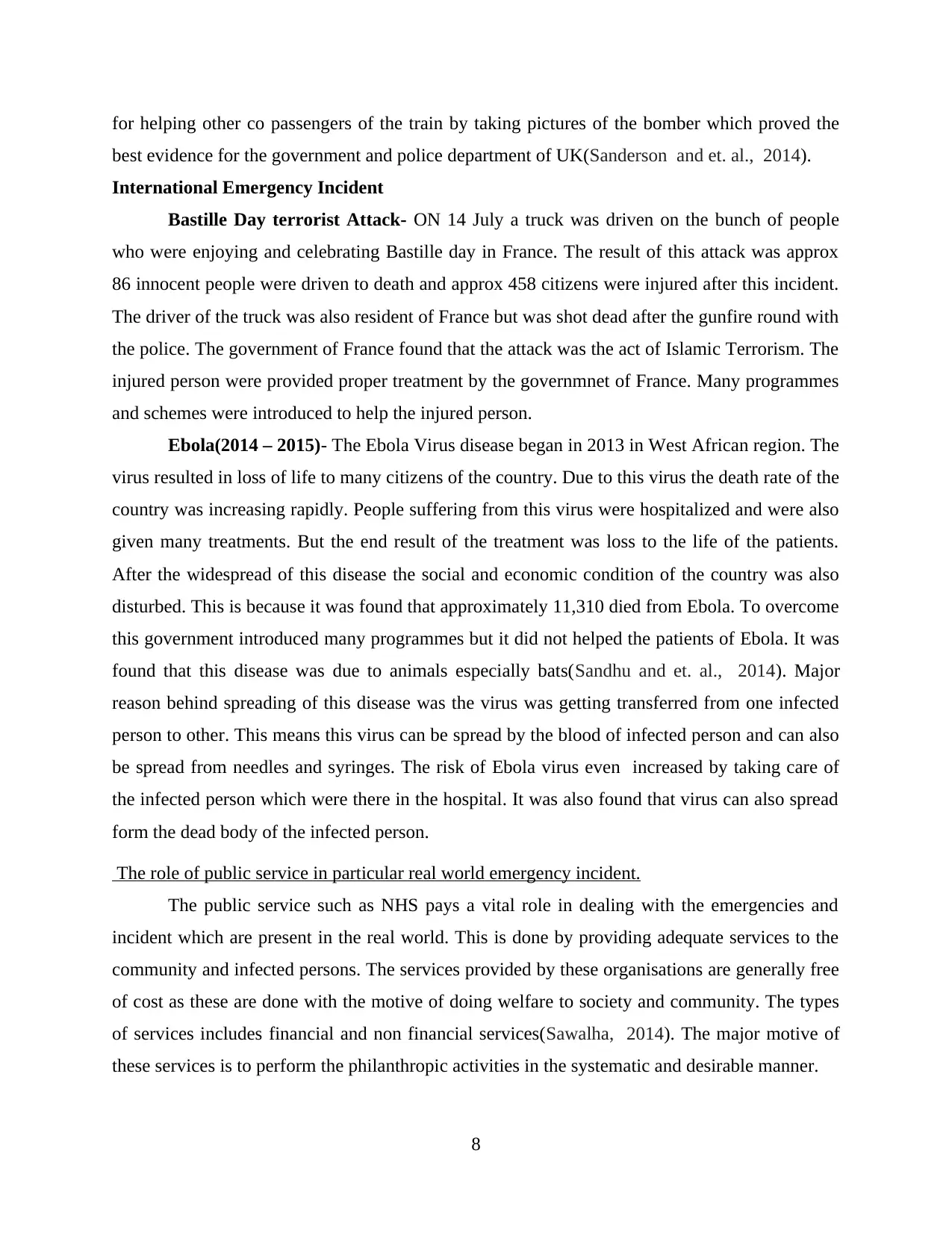
for helping other co passengers of the train by taking pictures of the bomber which proved the
best evidence for the government and police department of UK(Sanderson and et. al., 2014).
International Emergency Incident
Bastille Day terrorist Attack- ON 14 July a truck was driven on the bunch of people
who were enjoying and celebrating Bastille day in France. The result of this attack was approx
86 innocent people were driven to death and approx 458 citizens were injured after this incident.
The driver of the truck was also resident of France but was shot dead after the gunfire round with
the police. The government of France found that the attack was the act of Islamic Terrorism. The
injured person were provided proper treatment by the governmnet of France. Many programmes
and schemes were introduced to help the injured person.
Ebola(2014 – 2015)- The Ebola Virus disease began in 2013 in West African region. The
virus resulted in loss of life to many citizens of the country. Due to this virus the death rate of the
country was increasing rapidly. People suffering from this virus were hospitalized and were also
given many treatments. But the end result of the treatment was loss to the life of the patients.
After the widespread of this disease the social and economic condition of the country was also
disturbed. This is because it was found that approximately 11,310 died from Ebola. To overcome
this government introduced many programmes but it did not helped the patients of Ebola. It was
found that this disease was due to animals especially bats(Sandhu and et. al., 2014). Major
reason behind spreading of this disease was the virus was getting transferred from one infected
person to other. This means this virus can be spread by the blood of infected person and can also
be spread from needles and syringes. The risk of Ebola virus even increased by taking care of
the infected person which were there in the hospital. It was also found that virus can also spread
form the dead body of the infected person.
The role of public service in particular real world emergency incident.
The public service such as NHS pays a vital role in dealing with the emergencies and
incident which are present in the real world. This is done by providing adequate services to the
community and infected persons. The services provided by these organisations are generally free
of cost as these are done with the motive of doing welfare to society and community. The types
of services includes financial and non financial services(Sawalha, 2014). The major motive of
these services is to perform the philanthropic activities in the systematic and desirable manner.
8
best evidence for the government and police department of UK(Sanderson and et. al., 2014).
International Emergency Incident
Bastille Day terrorist Attack- ON 14 July a truck was driven on the bunch of people
who were enjoying and celebrating Bastille day in France. The result of this attack was approx
86 innocent people were driven to death and approx 458 citizens were injured after this incident.
The driver of the truck was also resident of France but was shot dead after the gunfire round with
the police. The government of France found that the attack was the act of Islamic Terrorism. The
injured person were provided proper treatment by the governmnet of France. Many programmes
and schemes were introduced to help the injured person.
Ebola(2014 – 2015)- The Ebola Virus disease began in 2013 in West African region. The
virus resulted in loss of life to many citizens of the country. Due to this virus the death rate of the
country was increasing rapidly. People suffering from this virus were hospitalized and were also
given many treatments. But the end result of the treatment was loss to the life of the patients.
After the widespread of this disease the social and economic condition of the country was also
disturbed. This is because it was found that approximately 11,310 died from Ebola. To overcome
this government introduced many programmes but it did not helped the patients of Ebola. It was
found that this disease was due to animals especially bats(Sandhu and et. al., 2014). Major
reason behind spreading of this disease was the virus was getting transferred from one infected
person to other. This means this virus can be spread by the blood of infected person and can also
be spread from needles and syringes. The risk of Ebola virus even increased by taking care of
the infected person which were there in the hospital. It was also found that virus can also spread
form the dead body of the infected person.
The role of public service in particular real world emergency incident.
The public service such as NHS pays a vital role in dealing with the emergencies and
incident which are present in the real world. This is done by providing adequate services to the
community and infected persons. The services provided by these organisations are generally free
of cost as these are done with the motive of doing welfare to society and community. The types
of services includes financial and non financial services(Sawalha, 2014). The major motive of
these services is to perform the philanthropic activities in the systematic and desirable manner.
8
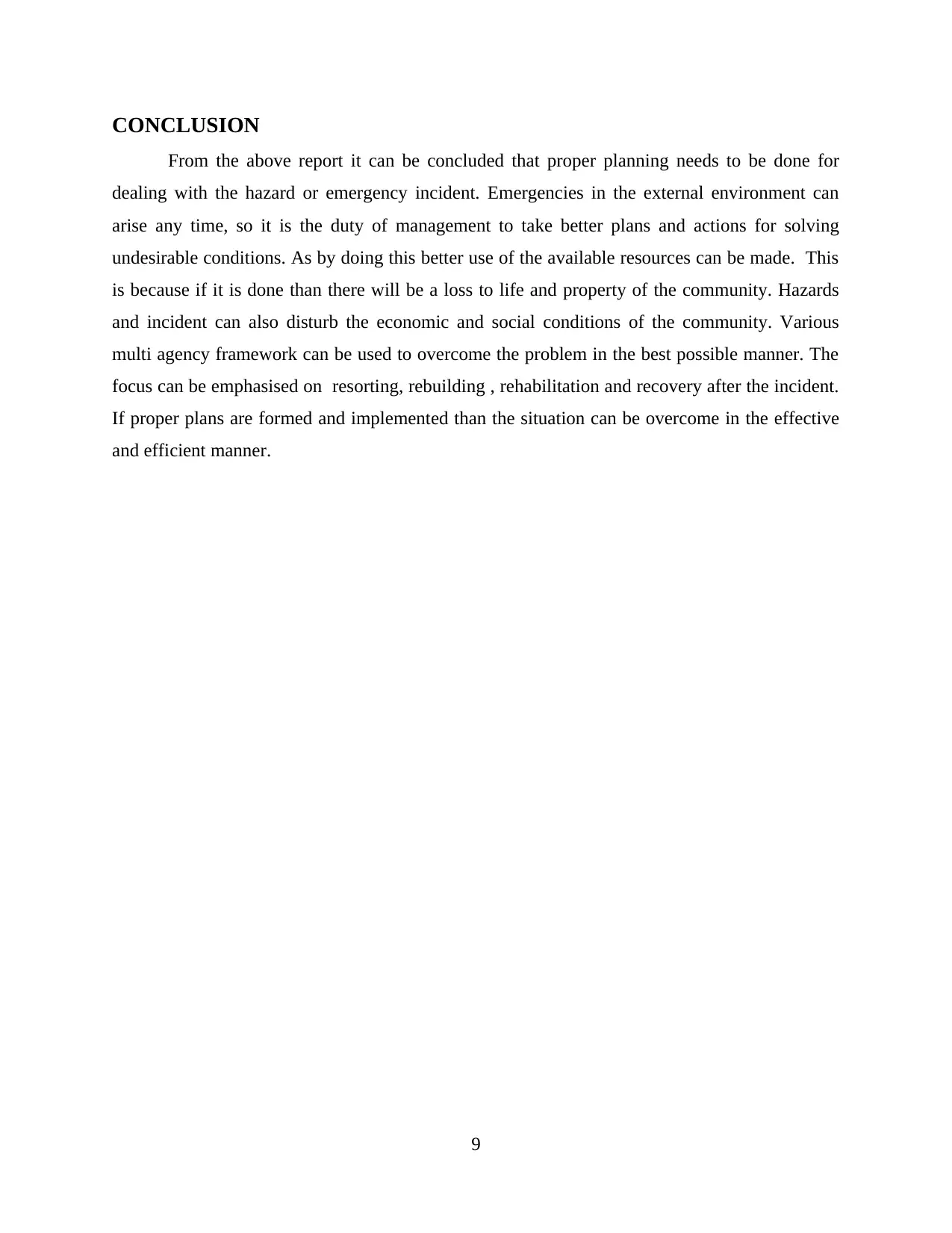
CONCLUSION
From the above report it can be concluded that proper planning needs to be done for
dealing with the hazard or emergency incident. Emergencies in the external environment can
arise any time, so it is the duty of management to take better plans and actions for solving
undesirable conditions. As by doing this better use of the available resources can be made. This
is because if it is done than there will be a loss to life and property of the community. Hazards
and incident can also disturb the economic and social conditions of the community. Various
multi agency framework can be used to overcome the problem in the best possible manner. The
focus can be emphasised on resorting, rebuilding , rehabilitation and recovery after the incident.
If proper plans are formed and implemented than the situation can be overcome in the effective
and efficient manner.
9
From the above report it can be concluded that proper planning needs to be done for
dealing with the hazard or emergency incident. Emergencies in the external environment can
arise any time, so it is the duty of management to take better plans and actions for solving
undesirable conditions. As by doing this better use of the available resources can be made. This
is because if it is done than there will be a loss to life and property of the community. Hazards
and incident can also disturb the economic and social conditions of the community. Various
multi agency framework can be used to overcome the problem in the best possible manner. The
focus can be emphasised on resorting, rebuilding , rehabilitation and recovery after the incident.
If proper plans are formed and implemented than the situation can be overcome in the effective
and efficient manner.
9
⊘ This is a preview!⊘
Do you want full access?
Subscribe today to unlock all pages.

Trusted by 1+ million students worldwide
1 out of 14
Related Documents
Your All-in-One AI-Powered Toolkit for Academic Success.
+13062052269
info@desklib.com
Available 24*7 on WhatsApp / Email
![[object Object]](/_next/static/media/star-bottom.7253800d.svg)
Unlock your academic potential
Copyright © 2020–2025 A2Z Services. All Rights Reserved. Developed and managed by ZUCOL.




